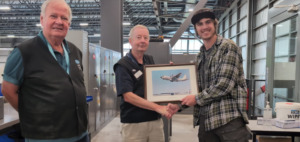Algonquin College student soars to new heights
Posted on Tuesday, October 22nd, 2024
A normal day of learning for 21-year-old aircraft maintenance technician student Brayden Krahn includes hands-on labs at the Canada

Canadian Aviation and Space Museum volunteers Peter Krayer and David Lowden present Brayden Krahn with a print of an airplane as a thank you gift.
Aviation and Space Museum. Experiential learning includes overhauling engines, airframe systems, learning about pressurization, radar and installing equipment and parts.
On Sept. 12, Krahn had finished class and was enjoying the perk of being able to walk around and visit the exhibits at the museum. He overheard two volunteer guides talking about one of the planes, so he edged closer and started talking to them. “They encouraged me to get in the cockpit,” said Krahn. “Then, they told me that the rudder pedals were broken.”
Krahn explained he was a student and he offered to look at the broken pedals. After grabbing his tools, he began his assessment and diagnosis.
The aircraft was a Canadair CT-114 Tutor. Built by Canadair in the 1960s, the two-seater jet was used for pilot training by the Royal Canadian Air Force (RCAF) and Canadian Forces from 1963 until 2000. The plane is best known as the aircraft used in air demonstrations by the Canadian Forces’ aerobatic team, the Snowbirds.
For the two volunteer guides, there was a personal connection. Peter Krayer and David Lowden were former Tutor pilots who had flown that plane when they served in the Canadian Armed Forces. “They told me that particular plane had a special place in their hearts,” said Krahn. “A lot of pilots have that connection to the first aircraft they did their first solo in.”
David Lowden had that personal connection. “I served in the RCAF as a pilot for some 30 years,” he said. “I flew the actual Tutor that Krahn repaired (Tutor 114055) a couple of times when it was a real aircraft, before it became a training aid and subsequently a museum exhibit. Because of my history with the aircraft, I was grateful that he volunteered to help. As I watched him work, I saw his passion for aircraft maintenance and his attention to detail.”
Peter Krayer saw that attention to detail as well. Krayer also served in the RCAF for 36 years and also flew a Tutor aircraft. He was impressed with how Krahn responded to the situation. “Totally of his own volition, he lowered himself down, headfirst to have a closer look, something we seventy-something year old volunteers could not do. He quickly analyzed and fixed the problem, even running to the Reserve Hangar to retrieve his personal tool kit. I was very impressed by Brayden’s initiative and outstanding work ethic. I can assure you that during my time as an Air Force squadron commander, I would have been grateful to have Brayden Krahn on my team.”
For Krahn, who is in his second year of the two-year program, repairing the broken pedals was a simple fix. He was able to secure a loose connection, tightly re-screw and refit the pedal and work under the instrument panel to secure the parts to resolve the issue.
He described the process as “really fun” and “a good feeling when you fix something and then it works and stays working.”
Krahn thought that would be the end of their interaction but a week or so later, the two gentlemen sought him out to thank him again for his assistance and gifted him with a print of Lockheed CC-130E Hercules.
When asked why he decided to stop and help, Krahn said he didn’t even hesitate. “I wanted to learn something. It’s an opportunity for something new and something fun to happen and I don’t want to pass this opportunity by. These gentlemen have been flying since my parents were kids and having a taste of their knowledge and experience, they had helped me carry something forward. I may be able to take this experience and apply it to something in the future.”
Image: Peter Krayer and David Lowden present Brayden Krahn with a print of an airplane as a thank you gift.
- Posted in
- Words
- Tags: